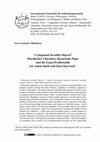Books by Gero Guttzeit

The Figures of Edgar Allan Poe is the first study to address the rhetorical dimensions of Poe’s t... more The Figures of Edgar Allan Poe is the first study to address the rhetorical dimensions of Poe’s textual and discursive practices. It argues that Poe is a figure and figurer of the emergence of the modern understanding of literature in the early nineteenth century that resulted from the birth of the romantic author and the so-called ‘death of rhetoric’. Building on accounts of Poe as a skilled navigator of American antebellum print culture, Gero Guttzeit reinterprets Poe as representative of the vital role that transatlantic rhetoric played in antebellum literature. He investigates rhetorical figures of the author in Poe’s critical writings, tales, poems, and lectures to give a new account of Poe’s significance for antebellum literary culture. In so doing, he also proposes a general rhetorical theory of theoretical, poetical, and performative figures of the author. Beyond Poe studies, the book intervenes in current debates on the romantic origins of the modern author and demonstrates that rhetorical theory offers new ways of exploring authorship beyond the nineteenth century.
Special Topic Journal Issues by Gero Guttzeit
Zeitschrift für Anglistik und Amerikanistik, 2024
Introduction to Contemporary Literature and Social Invisibility. Special issue of Zeitschrift für... more Introduction to Contemporary Literature and Social Invisibility. Special issue of Zeitschrift für Anglistik und Amerikanistik
Anglistik: International Journal of English Studies, 2019
Anglophone literature of the 19th century abounds in monsters that continue to horrify even in th... more Anglophone literature of the 19th century abounds in monsters that continue to horrify even in the present: vampires, mummies, doppelgangers, ghosts, and zombies as well as Frankenstein's monster, Moby-Dick, the Jabberwock, Helen Vaughan, and the Invisible Man. This issue of Anglistik remaps this monstrous abundance in light of the thriving field of monster studies.
Anglistik, 2019
Delineates a practice of monstrous reading and highlights some of its implications for literary a... more Delineates a practice of monstrous reading and highlights some of its implications for literary and cultural studies
This special issue seeks to explore the evolution of authorship across the long eighteenth centur... more This special issue seeks to explore the evolution of authorship across the long eighteenth century. The gradual development of a remunerative literary marketplace – driven by an expanding, economically viable periodical press as well as by authors’ greater abilities to leverage new copyright regimes – led to a process of professionalization that was fundamentally at odds with the traditional ideal of leisured authorship. The eighteenth-century economic realities of professional writers shaped competing conceptions of literary authorship. The stereotypes of the suffering Grub Street hack and of the Romantic genius represent two extremes, but situated and often alternating between these poles, a host of options presented themselves to those who would earn their living by writing.
Papers by Gero Guttzeit
African American Review, Mar 1, 2023
This paper analyzes a selection of covers of scholarly books from the field of
surveillance stud... more This paper analyzes a selection of covers of scholarly books from the field of
surveillance studies. Reading these book covers on their own as paratextual text-im-
age combinations, we seek to illuminate a seemingly marginal field of the contem-
porary representation of surveillance. Foregrounding the motifs of cameras, eyes,
and surveilled bodies, we point out some of the complex ways in which subjectivity
and in/visibility interact on book covers in the age of dataveillance.

Internationale Zeitschrift für Kulturkomparatistik, 2022
Article in German. English abstract:
“Compound Invisible Objects”: Moral Constitution, Literary C... more Article in German. English abstract:
“Compound Invisible Objects”: Moral Constitution, Literary Character and the Gyges Problem in Adam Smith and Eliza Haywood
A diachronic approach to the relationship between literature and philosophy since antiquity needs to include the field of rhetoric, regardless of whether it appears as a link or a disruption. This article discusses fundamental questions of rhetoric, philosophy, and poetics in the example of invisible characters and their moral qualities in antiquity and the mid-18th century. Plato’s mythical literary version of the Gyges legend in the “Republic” conceives of the invisible character as an illustration of the morally depraved nature of humans. In the following, I shall not trace this “Gyges problem” in the terms of influence studies but rather with an awareness of the ubiquity of ancient knowledge in philosophy and literature of the 18th century. I shall situate Adam Smith’s oft-discussed metaphor of the invisible hand in the context of his lectures on rhetoric, which were instrumental in founding the tradition of the Scottish New Rhetoric. I shall argue that invisibility forms a central element of Smith’s definition of character. The manifold implications of such a conception of invisible characters will then be illustrated using the example of Eliza Haywood’s “The Invisible Spy” (1755) and her conception of authorial ethos. Thus, the metaphor of invisibility proves itself to be of transhistorical relevance for the relationship
Handbook of the American Short Story
Forum for Modern Language Studies
This paper discusses early nineteenth-century authorship through an analysis of transgressive, do... more This paper discusses early nineteenth-century authorship through an analysis of transgressive, double and fragmented monsters in Gothic novels and tales. Relying on the concept of ‘figures of the author’, I read monsters such as the vampire, the doppelganger and the cyborg as Gothic refigurations of Romantic authorship. In analysing Mary Shelley’s Frankenstein (1818) and Edgar Allan Poe’s ‘Ligeia’ (1838) and ‘The Man that Was Used Up’ (1839), I examine how the characteristic othering of bodies, such as occurs in the Gothic monster, comes to be representative of the dangers that Gothic writing, in its monstrous and mechanical popularity, posed to the dominant idea of the Romantic author and its features such as individuality, originality and organic totality.











Uploads
Books by Gero Guttzeit
Special Topic Journal Issues by Gero Guttzeit
Papers by Gero Guttzeit
surveillance studies. Reading these book covers on their own as paratextual text-im-
age combinations, we seek to illuminate a seemingly marginal field of the contem-
porary representation of surveillance. Foregrounding the motifs of cameras, eyes,
and surveilled bodies, we point out some of the complex ways in which subjectivity
and in/visibility interact on book covers in the age of dataveillance.
“Compound Invisible Objects”: Moral Constitution, Literary Character and the Gyges Problem in Adam Smith and Eliza Haywood
A diachronic approach to the relationship between literature and philosophy since antiquity needs to include the field of rhetoric, regardless of whether it appears as a link or a disruption. This article discusses fundamental questions of rhetoric, philosophy, and poetics in the example of invisible characters and their moral qualities in antiquity and the mid-18th century. Plato’s mythical literary version of the Gyges legend in the “Republic” conceives of the invisible character as an illustration of the morally depraved nature of humans. In the following, I shall not trace this “Gyges problem” in the terms of influence studies but rather with an awareness of the ubiquity of ancient knowledge in philosophy and literature of the 18th century. I shall situate Adam Smith’s oft-discussed metaphor of the invisible hand in the context of his lectures on rhetoric, which were instrumental in founding the tradition of the Scottish New Rhetoric. I shall argue that invisibility forms a central element of Smith’s definition of character. The manifold implications of such a conception of invisible characters will then be illustrated using the example of Eliza Haywood’s “The Invisible Spy” (1755) and her conception of authorial ethos. Thus, the metaphor of invisibility proves itself to be of transhistorical relevance for the relationship
surveillance studies. Reading these book covers on their own as paratextual text-im-
age combinations, we seek to illuminate a seemingly marginal field of the contem-
porary representation of surveillance. Foregrounding the motifs of cameras, eyes,
and surveilled bodies, we point out some of the complex ways in which subjectivity
and in/visibility interact on book covers in the age of dataveillance.
“Compound Invisible Objects”: Moral Constitution, Literary Character and the Gyges Problem in Adam Smith and Eliza Haywood
A diachronic approach to the relationship between literature and philosophy since antiquity needs to include the field of rhetoric, regardless of whether it appears as a link or a disruption. This article discusses fundamental questions of rhetoric, philosophy, and poetics in the example of invisible characters and their moral qualities in antiquity and the mid-18th century. Plato’s mythical literary version of the Gyges legend in the “Republic” conceives of the invisible character as an illustration of the morally depraved nature of humans. In the following, I shall not trace this “Gyges problem” in the terms of influence studies but rather with an awareness of the ubiquity of ancient knowledge in philosophy and literature of the 18th century. I shall situate Adam Smith’s oft-discussed metaphor of the invisible hand in the context of his lectures on rhetoric, which were instrumental in founding the tradition of the Scottish New Rhetoric. I shall argue that invisibility forms a central element of Smith’s definition of character. The manifold implications of such a conception of invisible characters will then be illustrated using the example of Eliza Haywood’s “The Invisible Spy” (1755) and her conception of authorial ethos. Thus, the metaphor of invisibility proves itself to be of transhistorical relevance for the relationship
This paper examines the most representative cultural, poetical, and theoretical interrelations between antebellum eloquence and Poe’s poetry. Based on the assumption that antebellum poetry in general was “oratorical and occasional” (Wolosky 2010, 53), I shall argue that – in the time of the romantic opposition to rhetorical poetry (Mill [1833] 1981) – it was to elocutionary theories, discourses, and practices that Poe responded, partially affirming and partially subverting them in poems such as “Ulalume,” his recitations of his own and other authors’ poetry, and his critical theories, for instance, in “The Rationale of Verse.” My focus will be on the question how the notion that Poe’s compositions “require actual performance” by the reader (McGann 2013, 871) becomes explicable in terms of antebellum eloquence, ultimately suggesting some of the ways in which Poe’s connections to rhetorical culture are essential in “remapping” antebellum print culture (Kennedy and McGann 2013).
Articles
Appropriation: Towards a Sociotechnical History of Authorship
Adriaan van der Weel
Writer by Trade: James Ralph’s Claims to Authorship
William Thomas Mari
An “imperfect” Model of Authorship in Dorothy Wordsworth’s Grasmere Journal
Heather Meek
The Public, the Press, and Celebrities in The Return of Sherlock Holmes
Thomas Vranken
Reviews
Review: Sayad, Cecilia. Performing Authorship: Self-Inscription and Corporeality in the Cinema (London: Tauris, 2013)
Gerd Bayer